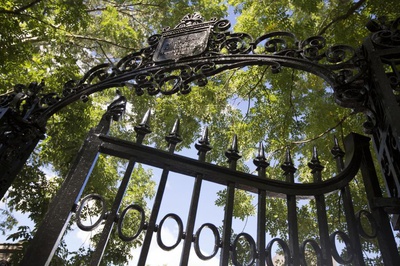
News
Harvard Grad Union Agrees To Bargain Without Ground Rules

News
Harvard Chabad Petitions to Change City Zoning Laws

News
Kestenbaum Files Opposition to Harvard’s Request for Documents

News
Harvard Agrees to a 1-Year $6 Million PILOT Agreement With the City of Cambridge

News
HUA Election Will Feature No Referenda or Survey Questions
Allston Residents React to Mass. Turnpike Realignment

As local and state officials await federal funds for the I-90 Multimodal Project, a long-running conversation is growing about just how the project should transform the neighborhood.
The Multimodal Project is a massive infrastructure investment that will realign the Massachusetts Turnpike in Lower Allston, depressing the elevated section and constructing a new commuter rail station. In the process, it will open up 60 acres of currently empty land – effectively creating a new neighborhood in Allston.
The Boston Planning and Development Agency has started probing residents to create a vision for the land. Harvard and Boston University have increased their funding commitments and local leaders are coalescing around a major push to advance the project.
In a promotional video last week, Massachusetts leaders promoted the project’s benefits, such as new pedestrian and cyclist infrastructure, increased public transportation, new river access, and opportunities for development.
Boston Mayor Michelle Wu ’07, Representative Ayanna Pressley (D-Mass.), state house Majority Leader Michael Moran, and Massachusetts Governor Maura Healey ’92 spoke in taped segments, each emphasizing the theme of the video: “The time is now.”
“This isn’t just a highway project. This is really a once in a generation opportunity to reimagine the western gateway to Boston,” Healey said in the video.
While nearly everyone agrees on the potential of the realignment to do enormous good for the neighborhood, how it will do so — and whether it can accommodate the goals of all its key stakeholders — is still a challenge ahead.
Locals engaged with the project have expressed weariness after already 10 years of planning — and at least three more ahead before construction even starts. They have also questioned whether some of the project’s promises will be seen through, including commitments to making new developments affordable and multimodal.
John A. Bruno, former chair of the Harvard Allston Task Force, said the process has already taken too long, despite the “committees and subcommittees and task forces” overseeing development.
“They started this conversation ten years ago, and nothing has come about, and that’s the frustrating part with the government and the realignment,” he said. As of now, the project is waiting for a viable financing plan to come together.
Environmental issues will be another ongoing challenge for the realignment.
The Charles River Watershed Association wrote in a 2022 comment letter to the Massachusetts Environmental Policy Act Office that the project did not have “enough flood mitigation measures,” which members reiterated in an interview this week.
Dira Johanif, who works on climate resilience issues for the CRWA, said the designs from the Massachusetts Department of Transportation “show risk of flooding for 2050 and 2070,” and in the event of a storm event, part of the I-90 will get flooded.
According to the letter, the current design also fails to prevent an excess amount of stormwater runoff, which could increase river pollution.
The CWRA called for the realignment to address urban heat islands — an urban area relatively warmer than surrounding suburban or rural areas — and to restore the riverbank.
The CWRA also wrote that the project should reduce the number of travel lanes to allow for more parkland and improve the environmental impacts of the turnpike.
Others are advocating to make sure that subsequent development in the area affordable — a concern as the regional housing crisis has been exacerbated by the arrival of the biotech sector and high-end development in Allston.
In an interview last month, Boston City Councilor Elizabeth “Liz” A. Breadon, who represents Allston and Brighton, said the project should support a locally-sourced workforce and encourage commuters to travel by public transit.
Like others, she cautioned against allowing the surrounding area to become “another Kendall Square,” referring to the expensive area near MIT that is a hub of biotechnology firms.
Rita M. DiGesse, who has lived in Allston since 1929, said she had reservations over whether the realignment could really knit the neighborhood together. DiGeese said that biotechnology and other big developments have undermined the intimacy that the area used to have.
She said the neighborhood has followed a clear trajectory since the Pike was first extended through Allston in 1964.
“Times change,” DiGeese said. “More cars, more people.”
—Staff writer Jina H. Choe can be reached at jina.choe@thecrimson.com.
—Staff writer Jack R. Trapanick can be reached at jack.trapanick@thecrimson.com. Follow him on X @jackrtrapanick.
Want to keep up with breaking news? Subscribe to our email newsletter.
From Our Advertisers

Over 300+ courses at prestigious colleges and universities in the US and UK are at your disposal.

Where you should have gotten your protein since 1998.

Serve as a proctor for Harvard Summer School (HSS) students, either in the Secondary School Program (SSP), General Program (GP), or Pre-College Program.

With an increasingly competitive Law School admissions process, it's important to understand what makes an applicant stand out.

Welcome to your one-stop gifting destination for men and women—it's like your neighborhood holiday shop, but way cooler.

HUSL seeks to create and empower a community of students who are seeking pathways into the Sports Business Industry.
